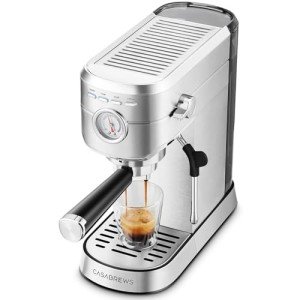20 Important Questions To Have To Ask About Italian Espresso Machines Before Buying It
Heat Exchange Espresso Machines: A Comprehensive Guide
Espresso machines have developed considerably over the years, accommodating the requirements of home baristas and coffee professionals alike. Amongst these machines, heat exchange espresso machines have gained popularity due to their capability to deliver constant efficiency and exceptional brew quality. In this article, we will explore the workings, advantages, and essential features of heat exchange espresso machines, providing a comprehensive understanding for both prospective purchasers and coffee lovers.
Understanding Heat Exchange Technology
Heat exchange espresso machines operate on a distinct principle that allows simultaneous water heating for brewing and steaming. They are geared up with a single boiler that makes use of a heat exchanger system. This feature is significant as it enables users to brew espresso while steaming milk simultaneously, promoting efficiency in the coffee-making process.
How Does a Heat Exchange Espresso Machine Work?
The procedure begins with the machine's water inlet filling the boiler. As the water warms up, it turns to steam. The ingenious heat exchanger utilizes hot steam to heat additional water in a separate passage designed particularly for the brew group. This means that water can reach the ideal brewing temperature without awaiting the boiler to adjust. The essential actions consist of:
- Water Fill: Water is drawn into the boiler.
- Heating Process: The boiler warms up as water is transformed into steam.
- Heat Exchange: Steam heats water in the heat exchanger tube.
- Brewing: Water from the heat exchanger is pushed through coffee grounds, drawing out the flavors needed for a rich espresso.
This process permits for fast temperature level adjustments and enhanced coffee extraction.
Advantages of Heat Exchange Espresso Machines
Heat exchange espresso machines provide several benefits, especially for those looking to maximize their coffee experience. Here are some essential benefits:
- Simultaneous Brewing and Steaming: Users can brew espresso while steaming milk, making it ideal for busy coffee shops and home baristas who value effectiveness.
- Temperature level Stability: The boiler's steam pressure helps maintain a steady temperature, which is vital for constant espresso extraction.
- Versatility: The style enables quick switching in between developing and steaming, making it simpler to create numerous coffee beverages, from lattes to cappuccinos.
- Easy to use: Models often feature available controls, making it possible for both newbies and knowledgeable baristas to produce quality beverages.
- Professional Quality: Heat exchange machines are often used in commercial settings, supplying users with high-quality brewing efficiency at home.
Secret Features to Look for in Heat Exchange Espresso Machines
When thinking about the purchase of a heat exchange espresso machine, there are a number of features that a person ought to consider:
- Build Quality: Look for machines made from long lasting materials, such as stainless steel or brass, making sure longevity.
- Boiler Size: A larger boiler will hold more water and sustain higher output gradually.
- PID Temperature Control: This feature assists maintain consistent brew temperatures, which can boost the coffee-making procedure.
- Group Head Design: Machines with a saturated or semi-saturated group head offer better temperature stability.
- Alleviate of Use: User-friendly user interfaces and user-friendly controls improve the total experience for baristas at all ability levels.
- Steam Wand Quality: An excellent steam wand with proper insulation and flexibility permits better texturing of milk.
- Water Reservoir Size: Depending on your requirements, consider how frequently you want to fill up the water reservoir.
Comparison of Popular Heat Exchange Espresso Machines
To better comprehend the choices available in the market, below is a comparison table of some popular heat exchange espresso machines:
Machine Model
Boiler Size
PID Control
Rate Range
User Ratings
Profitec Pro 700
2.0 L
Yes
₤ 2,000-₤ 2,500
9.5/ 10
Rocket Espresso R58
1.8 L
Yes
₤ 2,400-₤ 2,800
9.4/ 10
Elekta Bianca
1.8 L
Yes
₤ 2,500-₤ 3,000
9.6/ 10
La Spaziale S1 Vivaldi II
1.5 L
Yes
₤ 1,800-₤ 2,200
9.2/ 10
Bezzera Magica
1.2 L
No
₤ 1,600-₤ 1,800
9.0/ 10
Frequently Asked Questions About Heat Exchange Espresso Machines
What is the primary difference in between a heat exchange and a dual boiler espresso machine?
While both types can brew espresso and steam milk at the very same time, dual boiler machines have separate boilers for developing and steaming. On the other hand, heat exchange machines use a single boiler and a heat exchanger to attain the exact same function.
Are heat exchange machines suitable for beginners?
Yes! Many heat exchange machines are created with user-friendly functions, making them available for novices. With Coffeee and practice, users can rapidly produce quality espresso.
What kind of upkeep do heat exchange espresso machines need?
Routine maintenance consists of descaling, cleaning the boiler, checking seals and gaskets, and keeping the group head clean. Routine maintenance ensures durability and constant efficiency.
Can I use a heat exchange machine for various types of coffee drinks?
Definitely! Heat exchange machines allow users to produce a variety of coffee beverages, including espresso, lattes, coffees, and more.
Heat exchange espresso machines represent a mix of innovation and tradition, offering coffee lovers with the tools needed for crafting the perfect cup. Their capability to all at once brew and steam, combined with exact temperature level control, makes them a compelling option for both home baristas and experts. With the ideal understanding on features and upkeep, users can open a world of exquisite coffee experiences, ensuring that each sip is as delightful as the last.
